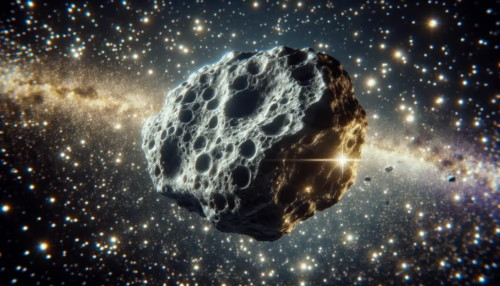Is Space Mining the Next Gold Rush on Asteroids? Have you ever wondered what lies beyond our earthly confines, waiting to be discovered? As our world becomes increasingly resource-strapped, a new frontier emerges: the unexplored wealth of space. But is space mining on asteroids the next gold rush, or is it just a far-fetched fantasy?

Table of Contents
The New Frontier: Space Mining
Space mining refers to the extraction of valuable minerals and other raw materials from asteroids and other celestial bodies. This concept could dramatically transform economies, provide untapped resources, and even serve as a catalyst for further space exploration. The idea is not as new as it might seem – science fiction writers and visionaries have pondered it for decades. However, it is only now beginning to shift from speculative fiction to tangible science.
Why Asteroids?
Asteroids, those seemingly insignificant celestial bodies, are considered prime targets for space mining for a variety of reasons. Chief among these is their rich abundance of rare metals and minerals that are increasingly scarce on Earth. Platinum, gold, cobalt, iron, and nickel are just a few examples of the materials that asteroids could offer in substantial quantities. These materials are critical not only for the manufacture of advanced technologies but also for major industrial applications.
The Economic and Scientific Implications
The potential economic impact of successful asteroid mining is staggering. Experts speculate that the space mining industry could, in time, surpass several trillions of dollars in value. However, the economic benefits are only part of the equation. Scientifically, mining asteroids can offer insights into the formation and composition of our solar system. These celestial bodies are considered to be remnants from the solar system’s formation, and any material extracted could yield clues to the past few billion years of cosmic history.
History and Context of Asteroid Mining
Understanding the history and evolution of space mining helps to contextualize its current standing and future potential. The concept of mining from space can be traced back to the likes of science fiction authors who envisioned humanity venturing beyond Earth’s constraints in search of new resources.
The Concept’s Origins
Space mining is deeply intertwined with the history of space exploration. The initial spark of interest grew in tandem with humanity’s first ventures beyond Earth. Just as explorers of the past ventured into unknown seas for gold and new lands, modern space explorers view asteroids and other celestial bodies as a similar kind of bounty.
Technological Progress and Legislative Milestones
Technological advancements have played a key role in advancing the field from concept to near-reality. The advent of new propulsion systems, robotics, and AI have fueled the possibilities of space mining. Furthermore, legislative progress in various countries, like the U.S. Commercial Space Launch Competitiveness Act of 2015, has begun to lay the groundwork for private companies to stake claims in space—a necessary step for the practicalities of space mining.

Understanding the Technical Approach
At the heart of space mining are the technical challenges and innovations required to make it feasible. The process is a monumental engineering challenge, demanding innovative solutions and approaches.
Effective Mining Techniques
Several proposed techniques for mining asteroids include the use of robotic spacecraft, which will autonomously extract resources and return them to Earth. Some companies have proposed using lunar or Martian resources to reduce costs associated with transporting materials from deeper space. Various methods like optical mining, where concentrated sunlight is used to vaporize and extract minerals, are being researched.
Robotics and AI: Pivotal Technologies
Robotics and AI are critical to the success of space mining ventures. Robotics technology allows for remote operations in the harshest environments, while AI provides the data processing power required for navigation, resource identification, and autonomous decision-making. These technologies work together to tackle the diverse challenges of mining, such as microgravity and extreme temperatures.
Commercial Ventures: Winners and Challengers
Several companies are vying to establish themselves within the burgeoning space mining market. Known as space mining pioneers, these firms are taking the first steps toward commercializing space resources.
Leading Companies in the Field
Pioneer companies like Planetary Resources and Deep Space Industries have spearheaded initial endeavors in asteroid mining. Their plans involve deploying small spacecraft to scout and study near-Earth asteroids before transitioning to full-scale mining operations. These startups have served as incubators for innovation, pushing the boundaries of what is traditionally possible.
| Company Name | Primary Focus | Noteworthy Accomplishments |
|---|---|---|
| Planetary Resources | Asteroid prospecting | First demonstration of Arkyd-3 satellite |
| Deep Space Industries | Resource extraction | Development of Harvester Spacecraft |
New Entrants and Future Prospects
With increasing interest from governments and private investors, new players are entering the space mining arena. This influx raises both excitement and challenges. As with any nascent industry, questions of feasibility, economic viability, and ethical considerations loom large, requiring collaborative efforts and strategic advancements.

Obstacles and Solutions: Crossing the Final Frontier
If asteroid mining is to become a reality, it must overcome a myriad of challenges, both technical and regulatory. These hurdles require creative solutions and collaboration across disciplines and nations.
Technical Challenges and Innovations
The harsh environment of space poses severe difficulties. Microgravity, space radiation, and extreme temperatures necessitate refined solutions in engineering and materials design. Innovative solutions like self-reparing robots that can withstand cosmic conditions are essential for successful missions.
Legal and Ethical Considerations
The legal labyrinth of space mining is just as complex. International space law remains an uncharted territory with many nations claiming that space should remain a “global commons.” Future regulations will need to strike a balance between commercial interests and global equity—ensuring resources are shared and not monopolized by a few entities.
The Environmental and Societal Impact
Beyond the intricate laws and technologies, it’s essential to consider the impact space mining could have on our planet and society. It’s important to ponder who stands to gain and lose with such monumental shifts in resource acquisition.
Environmental Implications
Asteroid mining could potentially alleviate environmental pressures on Earth by reducing the need for terrestrial mining, which often results in habitat destruction and pollution. With fewer demands on Earth’s resources, the planet could experience a decrease in industrial emissions and environmental degradation.
Societal and Economic Impact
The societal implications are equally profound. If conducted responsibly, space mining could enable unprecedented economic growth, provide jobs, and help bridge the resource gap between developed and developing nations. However, the industry also raises concerns about increased economic disparity, with companies and nations possessing advanced technology possibly accruing disproportionate advantages.

Futuristic Visions: Beyond Asteroids
While asteroid mining currently captures imaginations with its potential wealth, it is but the first step in humanity’s broader cosmic journey. The possibilities extend to mining the moon, Mars, and beyond.
Expanding to Lunar and Martian Resources
As technology advances, it becomes conceivable to extract materials from the moon and Mars. The abundance of resources like helium-3 on the moon could be pivotal for future energy needs, while Martian resources might support settlements on Mars and deeper space exploration missions.
The Role of International Collaboration
To harness the full potential of outer space resources, international collaboration will likely be pivotal. Unified treaties, collaborative research, and sharing of technology and information could pave the way for a truly inclusive space economy. Only through shared efforts can humanity hope to unlock and equally benefit from this final frontier.
Conclusion: The Threshold of a New Era
As we stand on the brink of an exciting new era, the prospects of space mining offer immense potential and significant challenges. If harnessed wisely, this “next gold rush” could transform our understanding of wealth, resource management, and technological progress, ultimately leading us to become true citizens of the cosmos.
What do you think are the foremost challenges and benefits of space mining? Share your thoughts and delve deeper into related topics, such as the future of space exploration and sustainability in space, for a broader understanding of humanity’s next great endeavor.

Why is asteroid mining the next gold rush in space exploration?

